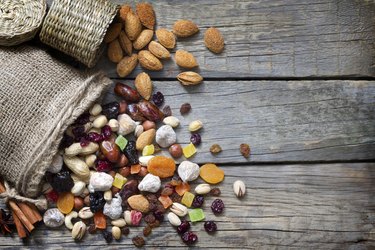
Eating a variety of dried fruit and nuts provides many healthy vitamins and minerals, fiber, carbohydrates and protein. Although it is possible to meet some of the dietary recommendations by eating only dried fruit and nuts, there are many essential nutrients that you would lack. Additionally, consuming a high quantity of fruit and nuts could result in an overconsumption of calories.
Healthiest Nuts
Video of the Day
Many types and varieties of nuts are available. According to the U.S. Food and Drug Administration, eating 1.5 ounces of specific nuts, including almonds, hazelnuts, pecans, some pine nuts, pistachio nuts and walnuts, as part of a low-fat, low-cholesterol diet may reduce the risk of cardiovascular disease. These nuts do not exceed 4 grams of saturated fat per 50 grams of nuts.
Video of the Day
Healthiest Fruits
Almost any fruits can be preserved by drying, which removes a large portion of the water content but preserves many nutrients. Some of these include grapes, apples, peaches, pears, plums, cherries, tomatoes, apricots and dates. Dried fruit is rich in fiber and low in fat with abundant potassium and protective bioactive compounds.
Protein
The DV, or daily value, for protein is 50 grams. Many nuts are efficient sources of protein -- almonds contain 6 grams of protein per 23 nuts and walnuts provide 6 grams per 14 halves. Dried fruits contain only a small amount of protein. A typical mixture of dried prunes, apricots and pears has less than 1 gram of protein per 40-gram serving.
Vitamins and Minerals
Dried fruits and nuts are beneficial sources of minerals, including calcium, iron, zinc, magnesium, selenium, phosphorous, copper, manganese and potassium, and are low in sodium. Most dried fruits are an effective source of vitamin A -- mixed fruit, with prunes, apricots and pears, provides 977 IU per 40 grams. The mixture supplies 12 to 14 percent of the daily value for vitamins B2, B3 and B6. Almonds and filberts are the best sources of vitamin E in nuts, providing nearly 25 percent of the DV per serving. One ounce of mixed nuts supplies B vitamins, 3 percent of the DV for calcium and 4 percent of the DV for iron.
Fat
Nuts and dried fruit contain no cholesterol, which is unnecessary in the diet because the body makes its own. Mono and polyunsaturated fat are beneficial for the heart and overall health. The recommendation for total fat from the diet is 65 grams. Dried fruit is low in total fat and contains mostly the good fats. Mixed nuts have a higher fat content, with 16 grams per ounce, most of which is monounsaturated.
Fruit and Nut Diet
You need to eat a large quantity of dried fruits and nuts for similar nutritional value from a well-balanced diet containing a variety of food groups to meet DV recommendations. The balance of nutrients and calorie intake will not provide optimal health benefits with such a limited diet. A dried fruit and nut diet does not contain enough vitamin C, a vitamin destroyed in the process of drying fruit, or any vitamin B12, only obtained from meat, eggs and dairy products. In addition, eating only dried fruits and nuts will not deliver adequate supplies of vitamins D, K or folic acid.